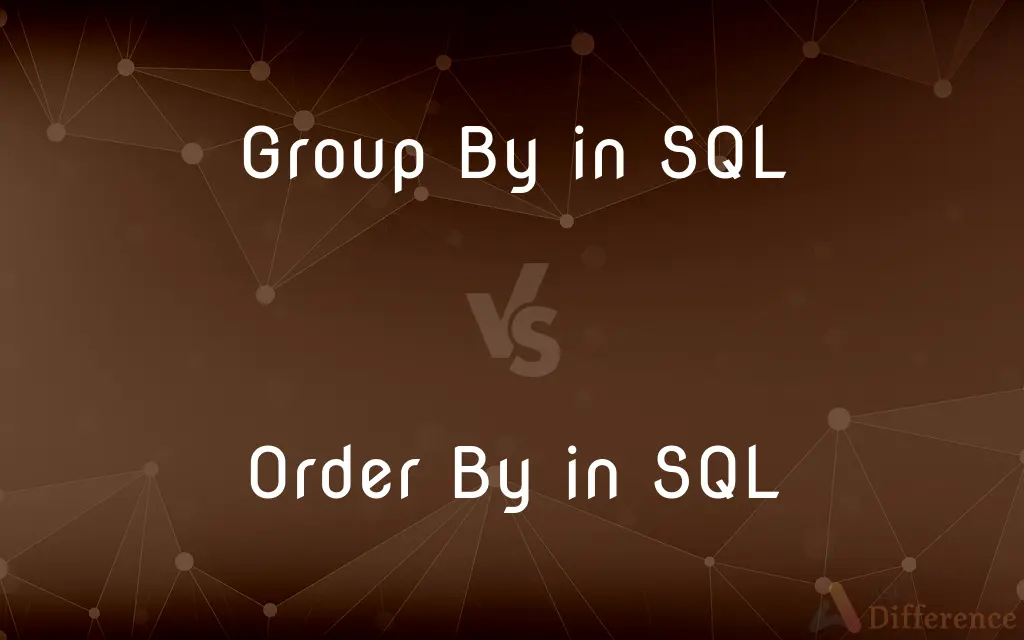Group By in SQL vs. Order By in SQL — What's the Difference?
By Tayyaba Rehman & Urooj Arif — Published on February 8, 2024
Group By in SQL aggregates data into groups based on common attributes, whereas Order By sorts the result set in ascending or descending order.

Difference Between Group By in SQL and Order By in SQL
Table of Contents
ADVERTISEMENT
Key Differences
In SQL, Group By is used to arrange identical data into groups, often combined with aggregate functions like COUNT, AVG, or SUM. Order By, on the other hand, is used to sort the result set of a query in either ascending or descending order based on one or more columns.
Group By plays a crucial role in data aggregation by categorizing rows with similar values into summary rows. In contrast, Order By does not aggregate data but simply arranges the rows of the result set based on specified column values.
While Group By changes the structure of the result set by merging rows, Order By maintains the original row structure, only altering the sequence in which they appear. Group By often goes hand in hand with aggregate functions, unlike Order By.
The use of Group By is essential in scenarios where understanding grouped data characteristics is necessary, such as in reporting and statistical analysis. Order By, however, is more about presentation, ensuring data is displayed in a readable and logical order.
In summary, Group By is fundamental for data analysis and aggregation in SQL, allowing for meaningful data groupings. Order By, while not altering the data itself, is key for organizing query results for readability and proper data interpretation.
ADVERTISEMENT
Comparison Chart
Function
Aggregates data into groups based on column values.
Sorts data in ascending/descending order.
Use with Aggregate Functions
Commonly used with functions like COUNT, AVG, SUM.
Not used with aggregate functions.
Result Structure
Alters the structure by grouping rows.
Maintains row structure, changes order only.
Purpose
For data analysis and grouping.
For organizing data presentation.
Dependency on Columns
Groups data based on specified columns.
Sorts data based on specified column values.
Compare with Definitions
Group By in SQL
Group By facilitates the use of aggregate functions on sets of data.
SELECT customer_id, AVG(order_amount) FROM orders GROUP BY customer_id;
Order By in SQL
Order By is used for organizing data for better readability.
SELECT employee_id, salary FROM employees ORDER BY salary DESC;
Group By in SQL
Group By helps in categorizing data based on column values.
SELECT status, COUNT(*) FROM orders GROUP BY status;
Order By in SQL
Order By in SQL enhances data presentation in query results.
SELECT title, release_year FROM movies ORDER BY release_year ASC;
Group By in SQL
Group By is used to organize similar data into groups in SQL.
SELECT category, SUM(sales) FROM products GROUP BY category;
Order By in SQL
Order By in SQL sorts the result set based on one or more columns.
SELECT name, age FROM students ORDER BY age DESC;
Group By in SQL
Group By in SQL creates a summarized data set from a larger table.
SELECT region, COUNT(order_id) FROM orders GROUP BY region;
Order By in SQL
Order By can arrange data in ascending or descending order.
SELECT product_name, price FROM products ORDER BY price ASC;
Group By in SQL
Group By in SQL aggregates rows that have the same values in specified columns.
SELECT department, COUNT(*) FROM employees GROUP BY department;
Order By in SQL
Order By does not change the data, only the order of display.
SELECT customer_name, order_date FROM orders ORDER BY order_date;
Common Curiosities
What is the primary purpose of Group By in SQL?
Group By is used to group rows that have the same values in specified columns for aggregation.
Is it possible to use both Group By and Order By in the same query?
Yes, Group By and Order By can be used together in a query for grouping and sorting data.
Can Order By sort data in both ascending and descending order?
Yes, Order By can sort data in ascending order (ASC) or descending order (DESC).
Can Group By be used without aggregate functions?
Typically, Group By is used with aggregate functions like COUNT, SUM, or AVG to provide summary data.
Does Group By affect the order of the result set?
Group By primarily groups data, but it can also influence the order, usually by the grouped column.
Are Group By and Order By only used in SELECT statements?
Yes, both Group By and Order By are typically used in SELECT statements.
What does Order By do in an SQL query?
Order By sorts the result set of a query in ascending or descending order based on specified columns.
Can I group data by multiple columns using Group By?
Yes, you can group data by multiple columns by listing them in the Group By clause.
What is the default sort order in SQL?
The default sort order in SQL is ascending (ASC).
Does the order of columns in Group By matter?
The order can affect the grouping results, especially when using multiple columns.
Is it necessary to include all selected columns in Group By?
All non-aggregated columns in the SELECT statement should be included in the Group By clause.
What happens if I don’t specify a direction in Order By?
If no direction is specified, Order By defaults to sorting in ascending order (ASC).
Can I use aliases in the Order By clause?
Yes, you can use column aliases in the Order By clause for sorting.
Can I use functions in the Order By clause?
Yes, you can use functions in the Order By clause to sort the results based on a computed value.
Can I use Order By with aggregate functions?
Yes, Order By can be used to sort the results of aggregate functions.
Share Your Discovery

Previous Comparison
Satin Nickel vs. Brushed Nickel
Next Comparison
Toaster vs. Toaster OvenAuthor Spotlight
Written by
Tayyaba RehmanTayyaba Rehman is a distinguished writer, currently serving as a primary contributor to askdifference.com. As a researcher in semantics and etymology, Tayyaba's passion for the complexity of languages and their distinctions has found a perfect home on the platform. Tayyaba delves into the intricacies of language, distinguishing between commonly confused words and phrases, thereby providing clarity for readers worldwide.
Co-written by
Urooj ArifUrooj is a skilled content writer at Ask Difference, known for her exceptional ability to simplify complex topics into engaging and informative content. With a passion for research and a flair for clear, concise writing, she consistently delivers articles that resonate with our diverse audience.













































